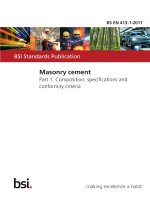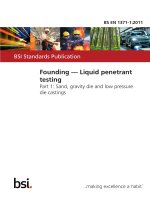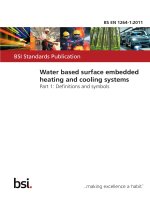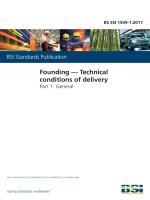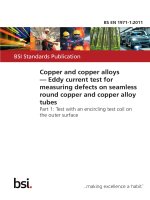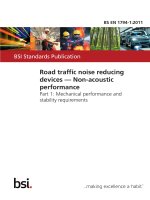Bsi bs en 62442 1 2011
Bạn đang xem bản rút gọn của tài liệu. Xem và tải ngay bản đầy đủ của tài liệu tại đây (1.24 MB, 22 trang )
BS EN 62442-1:2011
BSI Standards Publication
Energy performance of
lamp controlgear
Part 1: Controlgear for fluorescent
lamps — Method of measurement
to determine the total input power
of controlgear circuits and the
efficiency of the controlgear
BRITISH STANDARD
BS EN 62442-1:2011
National foreword
This British Standard is the UK implementation of EN 62442-1:2011,
incorporating CENELEC corrigendum May 2012. It is identical to
IEC 62442-1:2011. It supersedes BS EN 50294:1998, which will be withdrawn on 16 November 2014.
CENELEC corrigendum May 2012 adds supersession information to the
CENELEC foreword and title page.
The UK participation in its preparation was entrusted by Technical Committee
CPL/34, Lamps and Related Equipment, to Subcommittee CPL/34/3, Auxiliaries
for lamps.
A list of organizations represented on this subcommittee can be obtained on
request to its secretary.
This publication does not purport to include all the necessary provisions of a
contract. Users are responsible for its correct application.
© The British Standards Institution 2012.
Published by BSI Standards Limited 2012
ISBN 978 0 580 55708 8
ICS 29.140.99;17.220.20
Compliance with a British Standard cannot confer immunity from
legal obligations.
This British Standard was published under the authority of the Standards
Policy and Strategy Committee on 31 May 2012.
Amendments/corrigenda issued since publication
Date
Text affected
EUROPEAN STANDARD
EN 62442-1
NORME EUROPÉENNE
November 2011
EUROPÄISCHE NORM
Supersedes EN 50294:1998 + A1:2001 + A2:2003
ICS 29.140.99
English version
Energy performance of lamp controlgear Part 1: Controlgear for fluorescent lamps Method of measurement to determine the total input power of controlgear
circuits and the efficiency of the controlgear
(IEC 62442-1:2011)
Performance énergétique des
appareillages de lampes Partie 1: Appareillages des lampes à
fluorescence Méthode de mesure pour la détermination
de la puissance d'entrée totale des circuits
d'appareillage et du rendement des
appareillages
(CEI 62442-1:2011)
Energieeffizienz von
Lampenbetriebsgeräten Teil 1: Betriebsgeräte für
Leuchtstofflampen Messverfahren zur Bestimmung der
Gesamteingangsleistung von
Betriebsgeräteschaltungen und des
Wirkungsgrades von Betriebsgeräten
(IEC 62442-1:2011)
This European Standard was approved by CENELEC on 2011-11-16. CENELEC members are bound to comply
with the CEN/CENELEC Internal Regulations which stipulate the conditions for giving this European Standard
the status of a national standard without any alteration.
Up-to-date lists and bibliographical references concerning such national standards may be obtained on
application to the CEN-CENELEC Management Centre or to any CENELEC member.
This European Standard exists in three official versions (English, French, German). A version in any other
language made by translation under the responsibility of a CENELEC member into its own language and notified
to the CEN-CENELEC Management Centre has the same status as the official versions.
CENELEC members are the national electrotechnical committees of Austria, Belgium, Bulgaria, Croatia, Cyprus,
the Czech Republic, Denmark, Estonia, Finland, France, Germany, Greece, Hungary, Iceland, Ireland, Italy,
Latvia, Lithuania, Luxembourg, Malta, the Netherlands, Norway, Poland, Portugal, Romania, Slovakia, Slovenia,
Spain, Sweden, Switzerland and the United Kingdom.
CENELEC
European Committee for Electrotechnical Standardization
Comité Européen de Normalisation Electrotechnique
Europäisches Komitee für Elektrotechnische Normung
Management Centre: Avenue Marnix 17, B - 1000 Brussels
© 2011 CENELEC -
All rights of exploitation in any form and by any means reserved worldwide for CENELEC members.
Ref. No. EN 62442-1:2011 E
BS EN 62442-1:2011
EN 62442-1:2011
-2-
Foreword
The text of document 34C/987/FDIS, future edition 1 of IEC 62442-1, prepared by SC 34C, "Auxiliaries for
lamps", of IEC/TC 34, "Lamps and related equipment" was submitted to the IEC-CENELEC parallel vote
and approved by CENELEC as EN 62442-1:2011.
The following dates are fixed:
•
•
latest date by which the document has
to be implemented at national level by
publication of an identical national
standard or by endorsement
latest date by which the national
standards conflicting with the
document have to be withdrawn
(dop)
2012-08-16
(dow)
2014-11-16
This document supersedes EN 50294:1998 + A1:2001 + A2:2003.
Attention is drawn to the possibility that some of the elements of this document may be the subject of
patent rights. CENELEC [and/or CEN] shall not be held responsible for identifying any or all such patent
rights.
Endorsement notice
The text of the International Standard IEC 62442-1:2011 was approved by CENELEC as a European
Standard without any modification.
BS EN 62442-1:2011
EN 62442-1:2011
-3-
Annex ZA
(normative)
Normative references to international publications
with their corresponding European publications
The following referenced documents are indispensable for the application of this document. For dated
references, only the edition cited applies. For undated references, the latest edition of the referenced
document (including any amendments) applies.
NOTE When an international publication has been modified by common modifications, indicated by (mod), the relevant EN/HD
applies.
Publication
Year
Title
EN/HD
Year
IEC 60081
-
Double-capped fluorescent lamps Performance specifications
EN 60081
-
IEC 60901
-
Single-capped fluorescent lamps Performance specifications
EN 60901
-
IEC 60921
2004
Ballasts for tubular fluorescent lamps Performance requirements
EN 60921
2004
IEC 60929
+ corr. September
2011
2011
AC and/or DC-supplied electronic control
gear for tubular fluorescent lamps Performance requirements
EN 60929
2011
IEC 61347-2-3
-
Lamp controlgear EN 61347-2-3
Part 2-3: Particular requirements for a.c.
and/or d.c. supplied electronic control gear for
fluorescent lamps
-
IEC 61347-2-8
-
Lamp controlgear Part 2-8: Particular requirements for ballasts
for fluorescent lamps
EN 61347-2-8
-
–2–
BS EN 62442-1:2011
62442-1 © IEC:2011
CONTENTS
1
Scope ............................................................................................................................... 5
2
Normative references........................................................................................................ 5
3
Terms and definitions ....................................................................................................... 6
4
General ............................................................................................................................ 8
5
4.1 Applicability ............................................................................................................. 8
4.2 Declaration of ballast lumen factor ........................................................................... 8
4.3 Dimmable controlgear .............................................................................................. 8
4.4 Multi-wattage and/or multi-lamp controlgear ............................................................. 8
4.5 Accuracy of measurement ....................................................................................... 8
4.6 Sampling of controlgear for testing ........................................................................... 8
4.7 Number of samples.................................................................................................. 9
4.8 Conditioning of lamps .............................................................................................. 9
4.9 Test voltages and frequencies ................................................................................. 9
Method of measurement and calculation of total input power of controlgear –lamp
circuits and the efficiency of controlgear ............................................................................ 9
5.1
5.2
5.3
5.4
5.5
5.6
5.7
Annex A
Correction for ballast lumen factor ........................................................................... 9
Method of measurement .......................................................................................... 9
Measurement and calculation of the total input power of magnetic wire wound
controlgear – lamp circuits ..................................................................................... 10
Calculation of the efficiency of magnetic wire wound controlgear ............................ 10
Measurement and calculation of the total input power of electronic
controlgear –lamp circuits ...................................................................................... 10
Calculation of the efficiency of electronic controlgear ............................................. 12
Measuring the standby power................................................................................. 12
(normative) Energy performance measurement setup ............................................. 13
Annex B (informative) Application of the reference ballast when assessing lamps in
electronic operation ............................................................................................................... 17
Bibliography .......................................................................................................................... 18
Figure 1 – Configuration of lamp and photocell sensor ........................................................... 12
Figure A.1 – Measurement of magnetic wire wound controlgear – lamp circuits ...................... 13
Figure A.2 – Measurement of a.c. supplied electronic controlgear – lamp circuits .................. 14
Figure A.3 – Test setup for measuring standby power ............................................................ 14
Figure A.4 – Side view of light output measurement system ................................................... 15
Figure A.5 – Top view of light output measurement system .................................................... 15
Table 1 – Typical nominal electricity supply details for some regions ........................................ 9
BS EN 62442-1:2011
62442-1 © IEC:2011
–5–
ENERGY PERFORMANCE OF LAMP CONTROLGEAR –
Part 1: Controlgear for fluorescent lamps –
Method of measurement to determine the total input power
of controlgear circuits and the efficiency of the controlgear
1
Scope
This part of IEC 62442 defines a measurement and calculation method of the total input power
for controlgear ‒ lamp circuits when operating with their associated fluorescent lamp(s). The
calculation method for the efficiency of the lamp controlgear is also defined. This International
Standard applies to electrical controlgear lamp circuits consisting only of the controlgear and
the lamp(s). It is intended for use on a.c. supplies up to 1 000 V at 50 Hz or 60 Hz.
NOTE
Requirements for testing individual controlgear during production are not included.
It specifies the measurement method for the total input power and the calculation method of
the controlgear efficiency for all controlgear used for domestic and normal commercial
purposes operating with the following fluorescent lamps:
–
linear fluorescent lamps;
–
single-ended (compact) fluorescent lamps;
–
other general purpose fluorescent lamps.
This International Standard does not apply to:
–
controlgear which form an integral part of the lamp;
–
controllable wire-wound magnetic controlgear;
–
luminaires, which rely on additional optical performance aspects.
2
Normative references
The following referenced documents are indispensable for the application of this document. For
dated references, only the edition cited applies. For undated references, the latest edition of
the referenced document (including any amendments) applies.
IEC 60081, Double-capped fluorescent lamps – Performance specifications
IEC 60901, Single-capped fluorescent lamps – Performance requirements
IEC 60921:2004, Ballasts for tubular fluorescent lamps – Performance requirements
IEC 60929:2011, AC and/or DC-supplied electronic control gear for tubular fluorescent lamps –
Performance requirements
IEC 61347-2-3, Lamp control gear – Part 2-3: Particular requirements for a.c. and/or d.c.
supplied electronic control gear for fluorescent lamps
IEC 61347-2-8, Lamp controlgear – Part 2-8: Particular requirements for ballasts for
fluorescent lamps
–6–
3
BS EN 62442-1:2011
62442-1 © IEC:2011
Terms and definitions
For the purposes of this document, the following terms and definitions apply.
3.1
nominal value
suitable approximate quantity value used to designate or identify a component, device or
equipment
3.2
limiting value
the greatest or smallest admissible value of one of the quantities
3.3
rated value
quantity value for specified operating conditions of a component, device or equipment
The value and conditions are specified in the relevant standard or assigned by the
manufacturer or responsible vendor
NOTE
For the different kinds of operation, rated electrical values are given on the lamp data sheets as:
–
rated electrical values under “electrical characteristics”, if the lamp is defined for 50 Hz / 60 Hz
only,
operation
–
rated electrical values under “electrical characteristics”, if the lamp is defined for high frequency (≥ 20 kHz)
operation only,
–
rated electrical values and typical electrical values, if the lamp is defined simultaneously for 50 Hz / 60 Hz
operation and high frequency operation
for 50 Hz / 60 Hz operation: rated electrical values under “electrical characteristics”, and
for high frequency operation: rated electrical values under “typical lamp characteristics”.
3.4
controlgear
one or more components between the supply and one or more lamps which may serve to
transform the supply voltage, limit the current of the lamp(s) to the required value, provide
starting voltage and preheating current, prevent cold starting, correct power factor or reduce
radio interference
3.5
electromagnetic controlgear
controlgear which by means of inductance, or a combination of inductance and capacitance,
serves mainly to limit the current of the lamp(s) to the required value
Frequency of the lamp operation is the same as supply frequency.
3.6
electronic controlgear
a.c. and/or d.c. supplied to a.c. invertor including stabilizing elements for starting and operating
one or more tubular fluorescent lamps, generally at high frequency
3.7
fluorescent lamp
discharge lamp of the low pressure mercury type, in which most of the light is emitted by one or
several layers of phosphors excited by the ultra-violet radiation from the discharge
3.8
controlgear – lamp circuit
electrical circuit, or part thereof, normally built in a luminaire, consisting of the controlgear and
lamp(s)
BS EN 62442-1:2011
62442-1 © IEC:2011
–7–
3.9
reference ballast
special ballast, either inductive for lamps for operation on a.c. mains frequencies, or resistive
for lamps for operation on high frequency
It is designed for the purpose of providing comparison standards for use in testing ballasts, for
the selection of reference lamps and for testing regular production lamps under standardized
conditions. It is essentially characterized by the fact that, at its rated frequency, it has a stable
voltage/current ratio which is relatively uninfluenced by variations in current, temperature and
magnetic surroundings, as outlined in IEC 60929.
NOTE Annex B provides details of calculating the reference ballast characteristics and the method of operation
with the reference ballast.
3.10
reference lamp
lamp selected for testing controlgear which, when associated with a reference controlgear, has
electrical characteristics which are close to the rated values or typical lamp characteristics as
stated in the relevant lamp standard
For details regarding the tolerances, see Clause B.2.
3.11
rated supply voltage of a controlgear
voltage specified by the controlgear manufacturer for a given controlgear that applies to a
given operation condition
3.12
rated power of a lamp
P Lrated
power, expressed in watts, of a given lamp type specified by the manufacturer or the supplier,
the lamp being operated under specified conditions
3.13
ballast lumen factor
BLF
ratio of the light output of the reference lamp when the ballast under test is operated at its
rated voltage, compared with the light output of the same lamp operated with the appropriate
reference ballast supplied at its rated voltage and frequency
3.14
total input power
total power supplied to the controlgear – lamp circuit measured at rated input voltage
The rated power specified is related to a specific ballast lumen factor (BLF).
3.15
controlgear efficiency
η controlgear
ratio between the summation of the rated lamp power(s) and the corrected to reference
conditions input power of the controlgear – lamp circuit with possible sensors, network
connections and other auxiliary loads disconnected
3.16
multi-lamp-power controlgear
controlgear designed for the operation of one lamp which could have different lamp power
3.17
multi-number-lamp controlgear
controlgear designed for the operation of more than one lamp
–8–
4
BS EN 62442-1:2011
62442-1 © IEC:2011
General
4.1
Applicability
The measurement and calculation methods of this standard shall only be used for controlgear
which conforms to IEC 61347-2-3 or IEC 61347-2-8.
4.2
Declaration of ballast lumen factor
For every controlgear – lamp combination submitted for the test, the controlgear manufacturer
shall declare the measured ballast lumen factor. The ballast lumen factor is defined in 3.13.
BLF =
Lighttest
Lightref
(1)
where
Light ref
is the light output of reference lamp connected to reference ballast measured by
photocell meter reading;
Light test
is the light output of the reference lamp connected to the controlgear under test
measured by photocell meter reading.
The declared ballast lumen factor shall be in the range of 0,925 to 1,075. A controlgear with
lower ballast lumen factor is not suitable for testing. The upper limit of 1,075 may be exceeded,
if the value for maximum lamp operation current and maximum current in any lead to cathodes
comply with the rated value in IEC 60081 and IEC 60901.
4.3
Dimmable controlgear
Sufficient cathode temperature shall be produced by the heating circuit at any possible
dimming position within the available dimming range of the controlgear as specified by the
relevant datasheet in IEC 60081 and IEC 60901.
Dimmable controlgear shall be measured at 100 % and 25 % lumen output of the operated
lamp(s).
4.4
Multi-wattage and/or multi-lamp controlgear
If a controlgear is designed for the operation of one lamp with different lamp power then the
test shall be carried out for each lamp type, the manufacturer shall declare for every lamp the
relevant BLF. The test for multi-lamp controlgear shall be carried out with all possible
combinations.
4.5
Accuracy of measurement
The accuracy of the measurements shall be in accordance with A.1.2 and A.1.7 of IEC 60929.
The total accuracy of the measurement arrangement shall be within ± 1,5 % for magnetic wirewound controlgear – lamp circuits and ± 2,5 %, for electronic controlgear – lamp circuits,
including the accuracy of the photometric measurement.
4.6
Sampling of controlgear for testing
Tests in this standard are type tests. The requirements and tolerances specified in this
standard are based on the testing of a type test sample submitted by the manufacturer for that
purpose. This sample should consist of units having characteristics typical of the
manufacturer’s production and be as close to the production centre point values as possible.
BS EN 62442-1:2011
62442-1 © IEC:2011
4.7
–9–
Number of samples
One specimen shall be tested.
4.8
Conditioning of lamps
Lamps shall be handled and stabilized as described in B.1.1 of IEC 60081 and B.1.1 of
IEC 60901.
4.9 Test voltages and frequencies
Where the test voltage and frequency are not defined by national or regional requirements, the
test voltage and the test frequency shall be the nominal voltage and the nominal frequency of
the country or region for which the measurement is being determined ± 2 % (refer to Table 1).
Table 1 – Typical nominal electricity supply details for some regions
Country or region
Rated voltage and frequency
Europe
5
5.1
230 V, 50 Hz
North America
120 V, 277 V, 60 Hz
b
100 V, 50/60 Hz
Japan
a, c
China
220 V, 50 Hz
Australia and New Zealand
230 V, 50 Hz
a
Values are for single phase only. Some single phase supply voltages can be double the
nominal voltage above (centre transformer tap). The voltage between two phases of a threephase system is 1,73 times single phase values (e.g. 400 V for Europe).
b
“50 Hz” is applicable for the Eastern part and “60 Hz” for the Western part, respectively.
c
“If the manufacturer advises that for a marked voltage range a discrete value shall be used
for measurement, this should be observed.
Method of measurement and calculation of total input power of controlgear –
lamp circuits and the efficiency of controlgear
Correction for ballast lumen factor
The total input power measured is corrected to a BLF of 0,95 for wire-wound magnetic
controlgear and of 1,00 for high frequency (HF) electronic controlgear. Additionally tolerances
of reference lamps are compensated.
5.2
Method of measurement
The measurements are carried out with the power meter connected to measure the total input
power into the controlgear – lamp circuit, using:
–
for magnetic wire wound controlgear – lamp circuits:
the conditions specified in A.6.1 of IEC 60921:2004 and the test circuit of Figure A.1;
–
for a.c. supplied electronic controlgear – lamp circuits:
the conditions specified in A.6.2 of IEC 60921:2004, as far as applicable, and the test
circuit of Figure A.2.
The value of the total input power (P tot.meas. ) is recorded when a steady state has been
reached (controlgear temperature and lamp current stabilized).
– 10 –
BS EN 62442-1:2011
62442-1 © IEC:2011
The measurements with the controlgear under test in the controlgear – lamp circuit are to be
made with the rated supply voltage. P Lrated of a reference lamp, in some cases, may deviate
from the nominal value of the lamp.
5.3
Measurement and calculation of the total input power of magnetic wire wound
controlgear – lamp circuits
The measured total input power (P tot.meas. ) of a controlgear – lamp circuit is measured with
one controlgear and a reference lamp (or the number of reference lamps the controlgear is
designed to operate). The reference lamps shall conform to Annex D of IEC 60921:2004, in
addition the lamp current shall not deviate more than 1 % of the rated lamp current.
The measured total input power (P tot.meas. ) is corrected to a BLF of 0,95 and corresponds to
that value that would be given by the reference lamp with rated setting in order to minimize the
error caused by the variation of the characteristics of the reference lamps used.
The corrected total input power of the ballast-lamp circuit (P tot.ref. ) is calculated using the
following equation (2):
PLref.meas.
Ptot.ref. = Ptot.meas.
0,95 − (PLref.meas. − PLrated )
PLmeas .
(2)
where
P tot.ref.
is the total input power of the controlgear – lamp circuit under test corrected to
comparable reference conditions (in watts);
P tot.meas. is the measured total input power into the controlgear – lamp circuit under test (in
watts);
P Lref.meas. is the measured lamp power in the circuit with reference ballast (in watts);
P Lmeas.
is the measured lamp power in the circuit with test controlgear (in watts);
P Lrated.
is the rated lamp power of relevant reference lamp according to the lamp data sheet
(in watts).
5.4
Calculation of the efficiency of magnetic wire wound controlgear
The ballast lumen factor of 0,95 for the light output of lamps operated with magnetic wire
wound controlgear requires the calculation of the efficiency of the magnetic controlgear using
equation (3):
PLrated.
η controlgea r =
0,95
Ptot.ref.
5.5
(3)
Measurement and calculation of the total input power of electronic controlgear –
lamp circuits
The measured total input power (P tot.meas. ) of a controlgear – lamp circuit is measured with
one controlgear and one reference lamp (or the number of reference lamps the controlgear is
designed to operate). The reference lamps shall conform to Annex C of IEC 60929:2011, in
addition the lamp current shall not deviate more than 1 % of the rated lamp current.
The comparison between the controlgear circuit with the controlgear under test and the
controlgear – lamp circuit with reference ballast in accordance with A.6.1 or A.6.2, as far as
applicable, of IEC 60921:2004 is made with the same reference lamp using a photocell
positioned as shown in Figures A.4 and Figure A.5for measuring the light output of the lamp.
The measurements are carried out using the test circuit specified in Figure A.1.
NOTE 1 With electronic controlgear, measurements of power losses of the controlgear itself cannot be measured
accurately. Therefore, only the total input power method (measuring whole ballast-lamp circuits) can be carried out.
BS EN 62442-1:2011
62442-1 © IEC:2011
– 11 –
NOTE 2 Measurement in the Ulbricht sphere is accepted as an alternative to the ones prescribed in Figure A.3
and Figure A.4. The diameter of the sphere should be at least A+200 mm. For parameter A, see Figure A.4. In case
of doubt, the measurement using photocell (Figure A.3 and Figure A.4) should serve as reference.
The high frequency lamp current should be obtained with a tolerance of ± 1 % to that specified
to the rated current in the lamp standard. At the end of this procedure, the measured high
frequency lamp power (P Lref.meas. ) shall be within ± 2,5 % of the rated power of the lamp (see
electrical characteristics on lamp data sheets).
After reaching stable conditions (controlgear temperature and lamp current stabilized), the
measured value with the photocell is set at 100 %.
Under the same test conditions (positioning of the lamp and photocell unchanged) the
controlgear under test is connected to the lamp circuit and operated until stable conditions
again are reached.
The ratio of the light output of the lamp measured via the photocell when connected to the
controlgear under test to the light output of the lamp when connected to the reference ballast
shall be at least 92,5 %.
The total input power (P tot.meas. ) at the supply input of the controlgear under test is then
measured.
The measured total input power (P tot.meas. ) into the controlgear – lamp circuit under test is
corrected to a BLF of 1,00 (Light ref. /Light test ) and to minimize the error caused by the variation
of the characteristics of the reference lamp used (P Lrated. / P Lref.meas. ). The total input power
corrected (P tot.ref. ) of the controlgear – lamp circuit is calculated using the following
equation (4):
Ptot.ref. = Ptot.meas. ×
Lightref .
PLrated.
×
PLref.meas. Lighttest
(4)
where
P tot.ref.
is the total input power of the controlgear – lamp circuit under test corrected to
comparable reference conditions (in watts);
P tot.meas. is the measured total input power into the controlgear – lamp circuit under test (in
watts);
P Lrated.
is the rated lamp or typical HF power of relevant reference lamp according to the
lamp data sheet (in watts);
P Lref.meas. is the measured lamp power in circuit with reference ballast (in watts);
Light ref.
is the light output of reference lamp connected to reference ballast measured by
photocell meter reading;
Light test
is the light output of the reference lamp connected to the controlgear under test
measured by photocell meter reading.
For comparison of the light output measurement with the reference ballast and the light output
measurement with the controlgear under test, the light output measurement shall cover the
entire lamp surface. HF operation lamps may be operated with ‘hot’ or with ‘cold’ electrodes.
This will lead to a different light contribution from the lamp ends. It is therefore important that
the light from the lamp ends and the light from the middle part of the lamp is weighed equally.
The necessary condition is that the sensor is placed at the correct distance from the lamp. This
can be achieved by placing the sensor as shown in Figure 1.
The test position of the lamps shall be in accordance with the given position in the relevant
lamp standard IEC 60081 or IEC 60901.
BS EN 62442-1:2011
62442-1 © IEC:2011
– 12 –
The sensor signal X results from the luminosity Φx from the middle of the lamp, the sensor
signal X´ results from the luminosity Φx´ from the end of the lamp. The sensor signal resulting
from the luminosity of the lamp is proportional to the inverted square of the distance between
the sensor and the lamp:
X = Φx/R 2
X´ = Φx´/R´ 2
R´ = R/cos α
The difference between X and X´ resulting from the difference between R and R´ shall be
minimized. When a lamp is operated with ‘cold’ electrodes the light contribution from the lamp
end will be significantly lower compared with a lamp operated with ‘hot’ electrodes over a
distance of about 2 cm.
This leads to the following result:
X´ = (Φx´/R 2 ) cos 2 α
2
cos α > 0,95
cos α > 0,975
α < 13º,
tan α < 0,23
α is 13º (R=2L).
For the sensor, the angle of the incident radiation has no effect on the sensor signal strength
(within the 13º), therefore no cos α correction is used for the sensor.
When R = 2L, the error due to different contribution in light from centre of the lamp and lamp
end is maximum 0,3 %.
Figure 1 shows the relation between X, X´, R, R´, Φx and Φx´.
NOTE 3
Light output measurements can be done without assistance of an accredited laboratory.
X, X'
R
Φx
α
½L
R'
Φx'
IEC 2240/11
Figure 1 – Configuration of lamp and photocell sensor
5.6
Calculation of the efficiency of electronic controlgear
For the calculation of the efficiency of electronic controlgear, equation (5) should be used:
PLrated.
η controlgea r =
Ptot.ref.
5.7
PLref.meas. Light test
×
=
Light ref.
Ptot.meas.
(5)
Measuring the standby power
Standby power is measured for those controlgears which are permanently connected to the
mains where the lamps are switched off via a control signal. Other controlgear doesn’t have to
be tested. The measurement setup is described in Figure A.3.
BS EN 62442-1:2011
62442-1 © IEC:2011
– 13 –
Annex A
(normative)
Energy performance measurement setup
A.1
Measurement setup for magnetic wire wound controlgear
For the measurement of the total input power of magnetic controlgear and the measurement of
the lamp power, the measurement setup of Figure A.1 should be used.
Ballast
under test
Starter
V
Reference
ballast
Supply
V
V
A
Reference lamp
Supply
W
IEC 2241/11
Figure A.1 – Measurement of magnetic wire wound controlgear – lamp circuits
BS EN 62442-1:2011
62442-1 © IEC:2011
– 14 –
A.2
A.2.1
Measurement setup for electronic controlgear
Measurement of the total input power
Supply
V
W
Reference lamp
For the measurement of the total input power of electronic controlgear, the measurement of the
lamp power and the light output the measurement setup of Figure A.2 should be used.
Ballast
under test
A
Photocell
µA
W
V
Supply
V
Reference
ballast
IEC 2242/11
Figure A.2 – Measurement of a.c. supplied electronic
controlgear – lamp circuits
A.2.2
Measuring method of standby power
V
V
Supply
Reference lamp
The controlgear is connected as shown in Figure A.3; for multi-number-lamp controlgear, all
lamps are connected. Via the control input, a signal is given to switch the lamps off. After
visually checking whether the lamps are switched off, the input power is measured at the rated
supply voltage.
DUT
W
W
Control input
IEC 2243/11
Figure A.3 – Test setup for measuring standby power
BS EN 62442-1:2011
62442-1 © IEC:2011
A.2.3
– 15 –
Light output measurement
Figure A.4 and Figure A.5 show an example for the light output measurement of fluorescent
lamps.
l am p s
Lamps
370
50
100-200
100
50
Sensor
o
ve r
Overlamfull
p l ful l
eng
lamp length
th
5500
00
Anti-draught shield
IEC 2244/11
Dimensions in millimetres
NOTE 1 The sensors are in a box painted matt black internally to avoid reflected light. Lamps are placed
horizontally for linear double capped fluorescent lamps. For other lamps, the test position according to the relevant
lamp data sheet applies.
NOTE 2 The sensor view angle should be large enough to measure the total illuminance of the lamp(s) including
the cathodes.
NOTE 3 The distance of the sensor to the lamp(s) should be at least twice the lamp length in order to ensure that
the error, due to the different contributions of light from the centre of the lamp end, is a maximum of 0,3 %.
Figure A.4 – Side view of light output measurement system
Lamp holder
370
B
A
255
Sensor
A + 200
C
IEC 2245/11
Dimensions in millimetres
A = Lamp length
B = 1/2 lamp length
C = 2x lamp length
Figure A.5 – Top view of light output measurement system
– 16 –
BS EN 62442-1:2011
62442-1 © IEC:2011
Requirements for positioning in Figures A.4 and A.5:
a) Figures A.4 and Figure A.5 are used both for single and two lamp controlgear.
b) The same figures are used also for multi-number-lamp controlgear (3 or 4 lamps) with the
following provisions.
–
The measuring position of the lamps is for four lamps: two lamps next to each other and
two lamps above each other.
–
For three lamp controlgear, the measuring position is in the upper position, two lamps
next to each other, and in the lower position, one lamp in the centre.
The minimum distance from the light sensor to the lamp is set at least at 1 m. However the
sensor shall cover at least the lamp length plus 20 % of the lamp length.
For an amalgam lamp, care shall be taken that the reference measurements and test
measurements are always taken in the same position.
BS EN 62442-1:2011
62442-1 © IEC:2011
– 17 –
Annex B
(informative)
Application of the reference ballast when
assessing lamps in electronic operation
B.1
Calculation of the reference ballast impedance
The characteristics of the high frequency reference ballast for lamps in electronic operation are
deduced from the rated lamp voltage and rated lamp current of the relevant lamp data sheet. In
order to achieve the rated values of the reference ballast, twice the rated lamp voltage is
adjusted to the high frequency power supply. The rated current value, if not given on the lamp
data sheet, should be provided by the lamp manufacturer. The value of the low inductance
serial resistor is calculated from the rated lamp voltage and the rated lamp current. Definition
3.3 should be regarded in this respect.
B.2
Method of adjusting the lamp power
The reference ballast is represented with a low inductive resistor, which is calculated according
Clause B.1 by taking into consideration definition 3.3.
After stabilization HF supply voltage is adjusted until the high frequency lamp current is within a
tolerance of ± 1 % to that specified in the lamp standard. At the end of this procedure, the
measured high frequency lamp power (P Lref.meas. ) shall be within ± 2,5 % of the rated or typical
value.
– 18 –
BS EN 62442-1:2011
62442-1 © IEC:2011
Bibliography
IEC 62442-2___, Energy performance of lamp controlgear ‒ Part 2: Controlgear for high
intensity discharge lamps (excluding fluorescent lamps) ‒ Method of measurement to
determine the efficiency of controlgear 1
___________
___________
1
Under consideration.
This page deliberately left blank
NO COPYING WITHOUT BSI PERMISSION EXCEPT AS PERMITTED BY COPYRIGHT LAW
British Standards Institution (BSI)
BSI is the national body responsible for preparing British Standards and other
standards-related publications, information and services.
BSI is incorporated by Royal Charter. British Standards and other standardization
products are published by BSI Standards Limited.
About us
Revisions
We bring together business, industry, government, consumers, innovators
and others to shape their combined experience and expertise into standards
-based solutions.
Our British Standards and other publications are updated by amendment or revision.
The knowledge embodied in our standards has been carefully assembled in
a dependable format and refined through our open consultation process.
Organizations of all sizes and across all sectors choose standards to help
them achieve their goals.
Information on standards
We can provide you with the knowledge that your organization needs
to succeed. Find out more about British Standards by visiting our website at
bsigroup.com/standards or contacting our Customer Services team or
Knowledge Centre.
Buying standards
You can buy and download PDF versions of BSI publications, including British
and adopted European and international standards, through our website at
bsigroup.com/shop, where hard copies can also be purchased.
If you need international and foreign standards from other Standards Development
Organizations, hard copies can be ordered from our Customer Services team.
Subscriptions
Our range of subscription services are designed to make using standards
easier for you. For further information on our subscription products go to
bsigroup.com/subscriptions.
With British Standards Online (BSOL) you’ll have instant access to over 55,000
British and adopted European and international standards from your desktop.
It’s available 24/7 and is refreshed daily so you’ll always be up to date.
You can keep in touch with standards developments and receive substantial
discounts on the purchase price of standards, both in single copy and subscription
format, by becoming a BSI Subscribing Member.
PLUS is an updating service exclusive to BSI Subscribing Members. You will
automatically receive the latest hard copy of your standards when they’re
revised or replaced.
To find out more about becoming a BSI Subscribing Member and the benefits
of membership, please visit bsigroup.com/shop.
With a Multi-User Network Licence (MUNL) you are able to host standards
publications on your intranet. Licences can cover as few or as many users as you
wish. With updates supplied as soon as they’re available, you can be sure your
documentation is current. For further information, email
BSI Group Headquarters
389 Chiswick High Road London W4 4AL UK
We continually improve the quality of our products and services to benefit your
business. If you find an inaccuracy or ambiguity within a British Standard or other
BSI publication please inform the Knowledge Centre.
Copyright
All the data, software and documentation set out in all British Standards and
other BSI publications are the property of and copyrighted by BSI, or some person
or entity that owns copyright in the information used (such as the international
standardization bodies) and has formally licensed such information to BSI for
commercial publication and use. Except as permitted under the Copyright, Designs
and Patents Act 1988 no extract may be reproduced, stored in a retrieval system
or transmitted in any form or by any means – electronic, photocopying, recording
or otherwise – without prior written permission from BSI. Details and advice can
be obtained from the Copyright & Licensing Department.
Useful Contacts:
Customer Services
Tel: +44 845 086 9001
Email (orders):
Email (enquiries):
Subscriptions
Tel: +44 845 086 9001
Email:
Knowledge Centre
Tel: +44 20 8996 7004
Email:
Copyright & Licensing
Tel: +44 20 8996 7070
Email:
